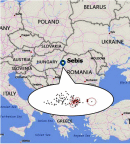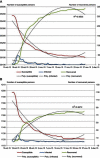Application of the susceptible-infected-recovered deterministic model in a GII.P17 emergent norovirus strain outbreak in Romania in 2015
- PMID: 31496766
- PMCID: PMC6701636
- DOI: 10.2147/IDR.S204175
Application of the susceptible-infected-recovered deterministic model in a GII.P17 emergent norovirus strain outbreak in Romania in 2015
Abstract
Purpose: This study shows the epidemiological profile of the first gastroenteritis outbreak of GII.P17 in the Romanian territory. An outbreak with such large amplitude in a European territory was previously undocumented.
Patients and methods: Using a cross-sectional design, with the susceptible-infected-recovered (SIR) deterministic compartmental model for a fixed population, and the cluster method for establishing the high-incidence zones, we carried out our investigation by means of questionnaires containing personal data, affected collectivities, disease onset and duration, symptoms displayed, medical assistance provided, previous antibiotic intake where applicable, food consumption and water sources, and sanitation conditions. The confirmation of cases was done based on the typical norovirus gastroenteritis symptomatology and using three laboratory confirmations (by molecular diagnosis) for GII.P17-GII.17 genotype noroviruses from three patients.
Results: A gastroenteritis outbreak occurred in October-November 2015, affecting 328 people in Arad, a county in Western Romania, covering 44 neighbouring localities with a total population of 35,440 people. The study detected an inter-human transmission of the infection, with an intrafamilial risk of disease of 2.26 (95% CI 1.76 to 2.90) compared with the community transmission (in school collectivity). The basic reproduction number Ro dropped from 1.26 to 0.18 during weeks 43:44, after controlling the transmission by decontamination and isolation.
Conclusion: SIR made it possible to highlight the expansion of the emerging norovirus strain infection from community to family collectivities. This study provides practical solutions to limit disease cases, even in the absence of etiology, and shows the importance of sometimes underestimated traditional control methods.
Keywords: SIR; basic reproduction number; norovirus, GII.17_Kawasaki.
Conflict of interest statement
The authors report no conflicts of interest in this work.
Figures



References
-
- Centers for Disease Control and Prevention. Updated norovirus outbreak management and disease prevention guidelines. MMWR Recomm Rep. 2011;60(RR03):1–15. Available from:: https://www.cdc.gov/mmwr/preview/mmwrhtml/rr6003a1.htm. Accessed July 11, 2019. - PubMed
-
- Bruggink LD, Moselen JM, Marshall JA. The molecular epidemiology of norovirus outbreaks in Victoria, 2014 to 2015. Commun Dis Intell Q Rep. 2017;41(1):E21–E32. - PubMed
LinkOut - more resources
Full Text Sources
Research Materials

